 |

 |
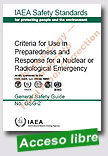 |
Criteria for Use in Preparedness and Response for a Nuclear or Radiological Emergency
IAEA Safety Standards Series, 2011, 91 p.
This Safety Guide presents a coherent set of generic criteria (expressed numerically in terms of radiation dose) that form a basis for developing the operational levels needed for decision making concerning protective and response actions. The set of generic criteria addresses the requirements established in IAEA Safety Standards Series No. GS-R-2 for emergency preparedness and response, including lessons learned from responses to past emergencies, and provides an internally |
consistent foundation for the application of radiation protection. The publication also proposes a basis for a plain language explanation of the criteria for the public and for public officials.
Contents: 1. Introduction; 2. Basic considerations; 3. Framework for emergency response criteria; 4. Guidance values for emergency workers; 5. Operational criteria; Appendix I: Dose concepts and dosimetric quantities; Appendix II: Examples of default oils for deposition, individual monitoring and contamination of food, milk and water; Appendix III: Development of EALs and example EALs for light water reactors; Appendix IV: Observables at the scene of a nuclear or radiological emergency.
Extraído de:
http://www-pub.iaea.org/MTCD/publications/PubDetails.asp?pubId=8506
|
 |
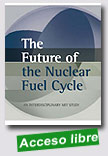 |
The Future of the Nuclear Fuel Cycle
MIT, 2011, 258 p.
The recent earthquake, tsunami, and subsequent nuclear accident in Japan occurred as this report was going to press. Our sympathies to the Japanese people.
The implications on the world energy system, beyond short-term price increases from greater use of oil and liquefied natural gas, are yet unknown and go beyond nuclear energy. From a technical perspective, there will be the lessons learned such as higher tsunami walls and the need for vented reactor containments that do not require emergency power for
|
operations. The broader conclusions are less clear. As of this writing there have been no off-site casualties as a consequence of the reactor accident under extreme events.
The accident included damage to reactors and to spent fuel storage pools. Both the reactor cores and the pools appear to be sources of radionuclide releases. The accident potential would have been greatly reduced if there were smaller inventories of spent fuel in pools. In the United States many utility spent fuel storage pools are full—a consequence of a failed repository program and the lack of a national spent nuclear fuel policy. The accident in Japan strongly argues for the United States to have a national spent fuel policy—rather than the ad-hoc policies that currently exist.
For policy reasons, we argue for a century planning horizon for spent fuel storage to maintain options for the future. We believe that spent fuel can be stored safety at the reactor, in a centralized facility, or in a repository with the option for future retrieval. The preferred technology for the reactor and centralized facilities is dry cask storage—a very robust storage option under extreme conditions. Some of the spend fuel at the Japanese reactor site is in dry storage.
The accident in Japan strengthens the case for either centralized spent fuel storage or disposal in a repository with the option for future recovery. The safety and security associate with a repository are many orders of magnitude greater than other spent fuel storage technologies—again arguing for a national priority to develop and build a geological repository for spent fuel and high-level wastes.
Report | Press release
Extraído de:
http://web.mit.edu/mitei/research/studies/nuclear-fuel-cycle.shtml |
 |
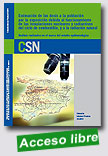 |
Estimación de las dosis a la población por la exposición debida al funcionamiento de las instalaciones nucleares y radiactivas del ciclo de combustible, y a la radiación natural
Consejo de Seguridad Nuclear, 2010, 372 p.
El Instituto de Salud Carlos III y el Consejo de Seguridad Nuclear suscribieron un convenio de colaboración en abril de 2006 con objeto de realizar el estudio solicitado por el Congreso de los Diputados, de acuerdo con los siguientes objetivos generales: estudiar la mortalidad por cáncer en los municipios situados en la proximidad de las instalaciones nucleares e instalaciones radiactivas del ciclo del combustible |
nuclear españolas en función de la historia de exposición a las emisiones derivadas del funcionamiento de las instalaciones, comparando con otros municipios españoles, de similares características sociodemográficas, no situados en el entorno de las instalaciones nucleares y contrastar la mortalidad por las mismas causas entre municipios en dos zonas seleccionadas según sus características de exposición a la radiación natural y no sometidas a la influencia de la operación de instalaciones nucleares o radiactivas del ciclo.
Extraído de:
http://www.csn.es/images/stories/
publicaciones/unitarias/informes_tecnicos/estudio_epidemiologico.pdf
|
 |
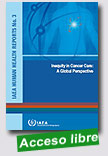 |
This publication was developed as part of the IAEA�s effort to contribute to the availability of integrated cancer prevention, diagnosis and treatment programmes in order to reduce the cancer burden worldwide. IAEA strategies have particularly focused on the needs of low and middle income countries and of vulnerable and marginalized populations. This book details causative factors of inequity in cancer care and discusses possible strategies to overcome them. It is expected to serve as a tool to create awareness about the role of socioeconomic |
equity in the access to cancer care with focus on radiotherapy services and eventually mobilize resources to be equitably allocated to public health programmes in general, and to cancer control and radiotherapy programmes in particular.
Extraído de:
http://www.csn.es/images/stories/publicaciones/
otras_publicaciones/guia_radia_web.pdf |
 |
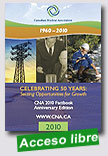 |
Celebrating 50 Years: Seizing Opportunities for Growth - CNA 2010 Factbook Anniversary Edition
Canadian Nuclear Association (CNA), 2010, 41 p.
On August 26, 1960 the Canadian Nuclear Association (CNA) was created to promote the peaceful use of nuclear technology in Canada. As we celebrate our 50th anniversary, with our proud history and many accomplishments, we look to the future with a vision of maintaining Canada's nuclear leadership role at home and around the world.
Canada is one of the nations that introduced the world to nuclear energy. In the years 1940-1942, George Laurence pioneered the
|
work on the first subcritical reactor at the National Research Council in Ottawa which was one of the first in the world to demonstrate a nuclearchain reaction. This brought international attention to Canada and branded our nation as a leader in cutting-edge science. Today, Canada's nuclear industry has achieved an unparalleled record of safe, reliable and economic nuclear power generation in three provinces. Nuclear energy is responsible for 15% of Canada's electricity production and for over 55% of Ontario's alone.
Extraído de:
http://cna.ca/english/pdf/nuclearfacts/2010/CNA_Booklet_2010.pdf |
 |
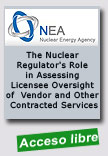 |
The Nuclear Regulator's Role in Assessing Licensee Oversight of Vendor and Other Contracted Services
Nuclear Energy Agency (NEA), 2011, 38 p.
Contracted services are an integral part of the design, construction and operation of a nuclear facility. Changes in the nuclear industry sector, including varied availability of nuclear expertise, the expansion of the international supply market and the introduction of new technologies, have tended to increase licensees’ use of contracted services. These changes have created challenges for licensees and regulators related to the
|
retention of nuclear expertise, the effective management of the interfaces between the licensees and contractors, and the oversight of contractor manufacturing quality in the context of greater multinational diversity. The regulatory body must address these challenges to provide assurance that the licensees maintain their responsibility for the safety of the facilities, regardless of who provides goods and services or where the activities involved in the supply chain take place. This report is intended to assist regulatory bodies in assessing their current practices for the regulatory oversight of licensees’ use of contractors, and adapting them where necessary to meet the evolving situation.
French version
Extraído de:
http://www.oecd-nea.org/tools/publication/index/period/6m/sort/date/filter/1#p6910
|
 |
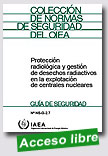
|
Protección radiológica y gestión de desechos radiactivos en la explotación de centrales nucleares - Guías de Seguridad
OIEA Colección de Normas de Seguridad, 2011, 87 p.
La finalidad de la presente Guía de seguridad es formular recomendaciones para el órgano regulador centradas en los aspectos operacionales de la protección radiológica y la gestión de desechos radiactivos de las centrales nucleares, así
como en los medios de garantizar el cumplimiento de los requisitos establecidos en las publicaciones de Requisitos de Seguridad pertinentes. Esta Guía también será de utilidad para el personal directivo superior de las entidades licenciadas o
contratistas encargado de establecer y administrar los programas de protecciónradiológica y de gestión de desechos radiactivos. |
Extraído de:
http://www-pub.iaea.org/MTCD/publications/PubDetails.asp?pubId=6560
|
 |
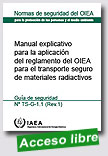 |
Manual explicativo para la aplicación del reglamento del OIEA para el transporte seguro de materiales radiactivos
OIEA Colección de Normas de Seguridad, 2011, 467 p.
En general el Reglamento de Transporte tiene por objetivo suministrar un nivel de seguridad adecuado y uniforme que se corresponda con el peligro inherente que presenten los materiales radiactivos que sean transportados. Dentro de lo posible, las características de seguridad deben ser incluidas en el diseño del bulto. Al depositar la confianza primordial en el diseño y la preparación del bulto, la necesidad de adoptar medidas especiales durante el transporte, es decir, por parte del transportista, queda reducida al mínimo. Sin embargo, para cumplir con los objetivos de seguridad se requieren algunos controles operacionales. |
Extraído de:
http://www-pub.iaea.org/MTCD/publications/PDF/Pub1325s_Web.pdf
|
 |
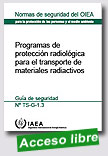 |
Programas de protección radiológica para el transporte de materiales radiactivos
OIEA Colección de Normas de Seguridad, 2011, 19 p.
La presente guía de seguridad brinda orientación para dar cumplimiento a los requisitos necesarios para el establecimiento de PPR relativos al transporte de materiales radiactivos con el fin de optimizar la protección radiológica y satisfacer los requisitos de protección radiológica en que se basa el Reglamento de Transporte. |
Extraído de:
http://www-pub.iaea.org/MTCD/publications/PDF/Pub1269s_Web.pdf
|
 |
|
|
|
|
|
